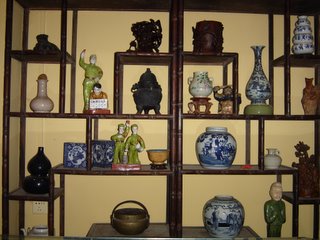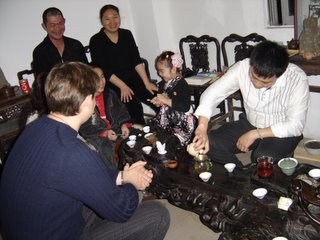
I had a delightful time at a tea house the other day. The laiason for the English academy (where Brenda is currently working part time for and where I might work next term), Cissi, invited us to visit the grand opening of her friends new tea house. I'm sure glad I went. It was such a cool experience. The main open room of the place was more like a museum. It was one of the nicest places I've been to in China, even though it was just a small shop. The owner collects Chinese antiques and traditional furniture that would've been used in palaces and for rich people. The chairs were made of the most beautiful red woods and carved intricately with all kinds of images like people or dragons. There was a wooden chest that I'm sure told a story of some battle. The room was very "feng shue"... right? Many people think that's a Japanese thing, but I'm told it originated in China. There were many cool furniture items, many just coppies of originals, but some of the items in this room seriously belong in a museum they are so old. Cissi told us about some of the items, like a ceramic bowl from such and such dynasty and a "pillow" which is actually a ceramic brick decorated like "china," with a slit on the side where they could keep their money safe. There was an entire collection of "watch dogs." The carved stone in the image of a dog that people used outside their homes to ward off evil spirits. Litterally hundreds, who knows maybe thousands of years old. Pretty amazing. Everything has a story. After a nice tour through the collection, we headed up stairs for tea.
Having tea in China is not a simple casual thing. They take their tea very seriously. Tea is an art. Everything about t
 he whole tea drinking process has a meaning. It's like a ritual or ceremony. But it's also a time of just being together and enjoying the tea. Every kind of tea has a special purpose. If you have indigestio, there is a special tea for that. If you have a cold, there is a special tea for that. If you want to keep healthy, there are several teas for that. If you are a man, there is a special tea for you. If you are a woman there is another kind of tea for you. Chinese take great care in preparing tea leaves. Tea leaves are like wine. The older they are, the better and more expensive they are. Chinese like to dry their leaves whole. Some kinds are stored loosely, and some are rolled into hard, dense "frisbee" shapes where you take a small chunk off at a time for seeping. Chinese tea is different from Japanese. The Japanese like to crumble their leaves very fine which makes the tea more bitter and stronger. The whole process of seeping the tea and serving the tea is an art. We are each given a tiny ceramic tea cup. They look like little bowls small enough for a doll house. But they don't drink tea just to drink. It's a special time of tasting and enjoying. First each cup is filled with hot water. Then the tea dude (I'm sure there's a more propper name for him, but I don't know what it is) uses his special tongs to pick up each cup and swishes around the water to clean the dish. All the water he just lets fall onto the table. Even the table is special. This particular one is made from a large chunk of petrified hard red wood that sat at the bottom of the sea for hundreds of years, then was carved into the s
he whole tea drinking process has a meaning. It's like a ritual or ceremony. But it's also a time of just being together and enjoying the tea. Every kind of tea has a special purpose. If you have indigestio, there is a special tea for that. If you have a cold, there is a special tea for that. If you want to keep healthy, there are several teas for that. If you are a man, there is a special tea for you. If you are a woman there is another kind of tea for you. Chinese take great care in preparing tea leaves. Tea leaves are like wine. The older they are, the better and more expensive they are. Chinese like to dry their leaves whole. Some kinds are stored loosely, and some are rolled into hard, dense "frisbee" shapes where you take a small chunk off at a time for seeping. Chinese tea is different from Japanese. The Japanese like to crumble their leaves very fine which makes the tea more bitter and stronger. The whole process of seeping the tea and serving the tea is an art. We are each given a tiny ceramic tea cup. They look like little bowls small enough for a doll house. But they don't drink tea just to drink. It's a special time of tasting and enjoying. First each cup is filled with hot water. Then the tea dude (I'm sure there's a more propper name for him, but I don't know what it is) uses his special tongs to pick up each cup and swishes around the water to clean the dish. All the water he just lets fall onto the table. Even the table is special. This particular one is made from a large chunk of petrified hard red wood that sat at the bottom of the sea for hundreds of years, then was carved into the s hape of a dragon with random parts of his back made flat like a table. All the flat parts are curved just right so that all the water spilled from the cups flows down into a little hole cut into the wood. The tea leaves are carefully selected by the tea dude which he puts into a larger ceramic cup, then he pours water over them. He doesn't just pour water on them to make them get wet and seep out the tea-ee goodness. He pours the water in a circle, slowly all around the dish til it's at the perfect amount. Cissi says this means something like the moon is going around the flower and the flower blooms (the tea leaves expand as they soak up the water). The way she said it was much more poetic. But it's pretty cool. After the water is poored, he quickly covers it, and lets seep for a bit. Then he moves the lid around and around the dish, almost as if to cover all that he can with tea, then he holds the cup in a certain way, with a certain finger over the top of the dish, and moving the lid at a certain angle, then pouring the tea into a small clear glass pourer. Then he fills each of our tiny ceramic cups with a taste of tea, always starting with the person to his left and going around the table. This first cup of tea is also for washing our cup, so we dump it on this little sandstone or pummice carved bull dog. Yeah, that makes no sense. But we end up getting the table all wet with tea. Then he does the whole process again and again, filling our cups. When we drink the tea, we are first to smell it, then drink. See, like wine tasting or something. Not that I've ever done that before. Then when your cup is gone, you smell the cup. It sounds all very silly. But it's actually quite enjoyable. It's refreshing to just enjoy a taste and a sensation that something as simple as tea can bring, instead of just gluttonizing over every consumption and not thinking about it's uniquness. We tried a few different teas that night I think. Pretty cool.
hape of a dragon with random parts of his back made flat like a table. All the flat parts are curved just right so that all the water spilled from the cups flows down into a little hole cut into the wood. The tea leaves are carefully selected by the tea dude which he puts into a larger ceramic cup, then he pours water over them. He doesn't just pour water on them to make them get wet and seep out the tea-ee goodness. He pours the water in a circle, slowly all around the dish til it's at the perfect amount. Cissi says this means something like the moon is going around the flower and the flower blooms (the tea leaves expand as they soak up the water). The way she said it was much more poetic. But it's pretty cool. After the water is poored, he quickly covers it, and lets seep for a bit. Then he moves the lid around and around the dish, almost as if to cover all that he can with tea, then he holds the cup in a certain way, with a certain finger over the top of the dish, and moving the lid at a certain angle, then pouring the tea into a small clear glass pourer. Then he fills each of our tiny ceramic cups with a taste of tea, always starting with the person to his left and going around the table. This first cup of tea is also for washing our cup, so we dump it on this little sandstone or pummice carved bull dog. Yeah, that makes no sense. But we end up getting the table all wet with tea. Then he does the whole process again and again, filling our cups. When we drink the tea, we are first to smell it, then drink. See, like wine tasting or something. Not that I've ever done that before. Then when your cup is gone, you smell the cup. It sounds all very silly. But it's actually quite enjoyable. It's refreshing to just enjoy a taste and a sensation that something as simple as tea can bring, instead of just gluttonizing over every consumption and not thinking about it's uniquness. We tried a few different teas that night I think. Pretty cool.

No comments:
Post a Comment